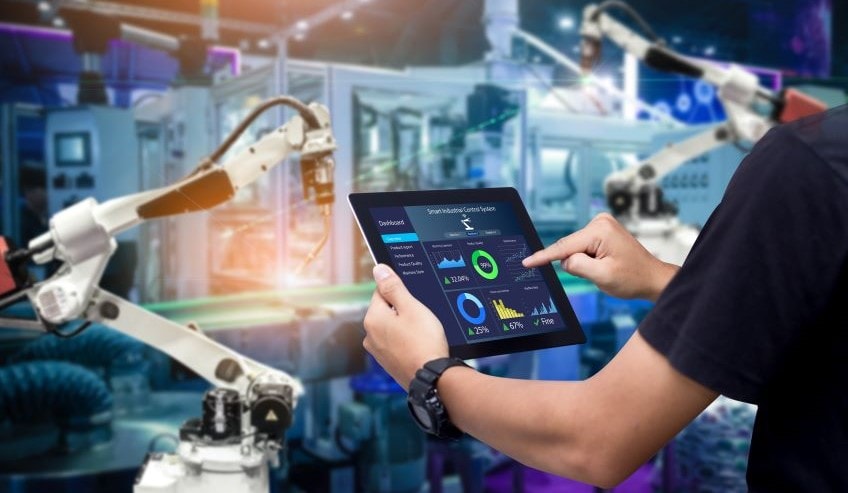
The Glue Talk Blog

Artificial Intelligence (AI) tends to conjure up images of supercomputers outsmarting humans or replacing them. But, time and advancements in technology have proven that humans and AI work together splendidly by better enhancing processes and providing a multi-faceted approach to manufacturing, distribution, and more.
At H.B. Fuller, we took a look at the latest in cutting-edge technology and, more specifically, how the future of manufacturing will be using AI to make products more efficiently.
Industry 4.0, Data, and IoT
The fourth industrial revolution is transforming manufacturing and distribution through the connection of smart devices, and cooperation between humans and AI. Processes can be improved through real-time data that can adjust anything from ideal warehouse temperatures with a smart thermostat to machines that can perform optimized tasks alongside humans for all-around better efficiency. The Internet of Things (IoT) connects devices through smart technology integration, and this can be applied anywhere from regulating the humidity in the room to the temperature on the floor.
The real-time data collected from AI systems can be applied to anticipate hitches in processes, optimal staffing, any possible flaws in market trends that can negatively impact services, upcoming maintenance on components or parts, ideal assembly line composition or changes, weather conditions that can affect distribution, and optimal distribution and manufacturing logistics. Operations can shift from a reactionary strategy to anticipatory and preemptive, which can create more bandwidth for analysis and innovation.
Predictive Maintenance
AI can anticipate the upcoming needs of manufacturing equipment, whether maintenance is necessary, or anything that needs to be completely replaced. The real-time data can also monitor machines to consistently diagnose anything out of the ordinary, such as a higher than normal temperature. This helps manufacturers stay ahead of the curve and begin to plan out their maintenance schedules and budgeting based on this data (rather than face any unpredictable maintenance or any “invisible” problems that can dovetail into something more serious).
Generative Design
Designers and engineers can pour their expertise and ideas into software that generates designs while honoring a series of constraints. For instance, an AI program can analyze a design and anticipate its multiple uses while also accounting for budget constraints, material needs, transportation logistics, staffing needs, and possible design flaws. Together, the designer or engineer can generate a model that includes the objective calculations of an intelligent system with the creativity and innovation of humans — all in an effort to create the best possible outcome.
Just as artificial intelligence is poised to help your business, H.B. Fuller is ready to provide solutions for your distribution and manufacturing needs. Contact us to learn more.
Blog Categories
Blog Categories
Archive
- 2024
- 2023
- 2022
-
2021
- January (3)
-
February (7)
- Celebrating Exceptional Service During COVID-19 Complications
- Cyanoacrylates: What They Are and What They Do
- Innovative two-shot bookbinding adhesive
- Make a Difference 2020
- Problem Solving: Paper Straws in Drinking Beverages
- Stronger straws sustainable future
- Substances of Interest in Disposable Absorbent Hygiene Products
- March (4)
- April (4)
- May (4)
- June (5)
- July (2)
- August (5)
- September (2)
- October (1)
- November (3)
- December (2)
-
2020
- January (4)
- February (2)
- March (3)
- April (4)
- May (3)
-
June (7)
- Community Support in the Era of Coronavirus
- HBFuller Employee Creates Face Shields with 3D Printer
- Improved Packaging Integrity and Greater Customer Satisfaction
- Liquid-Resistant Paper Straws
- What is a Sealant?
- What Is the Future of Commercial Disinfectants?
- Winning over consumers with e-commerce packaging solutions
-
July (6)
- Employees Take Action to be Part of Healing and Growth
- Gain a competitive advantage with packaging adhesive solutions
- HB Fuller Company Foundations Commitment to Communities
- Packaging Solutions for the South African Agriculture Market
- Supporting Organizations That Provide STEM Education for Youth
- Where Does Sustainability Stand Amid COVID-19
- August (3)
- September (2)
- October (4)
- November (2)
- December (4)
